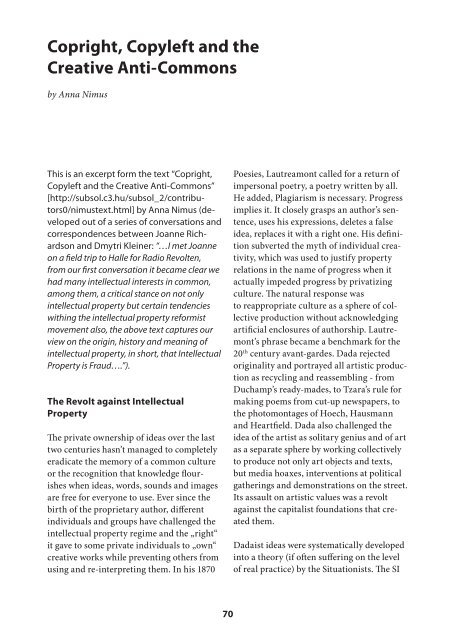Create successful ePaper yourself
Turn your PDF publications into a flip-book with our unique Google optimized e-Paper software.
Copright, Copyleft and the<br />
Creative Anti-Commons<br />
by Anna Nimus<br />
This is an excerpt form the text “Copright,<br />
Copyleft and the Creative Anti-Commons”<br />
[http://subsol.c3.hu/subsol_2/contributors0/nimustext.html]<br />
by Anna Nimus (developed<br />
out of a series of conversations and<br />
correspondences between Joanne Richardson<br />
and Dmytri Kleiner: “…I met Joanne<br />
on a field trip to Halle for Radio Revolten,<br />
from our first conversation it became clear we<br />
had many intellectual interests in common,<br />
among them, a critical stance on not only<br />
intellectual property but certain tendencies<br />
withing the intellectual property reformist<br />
movement also, the above text captures our<br />
view on the origin, history and meaning of<br />
intellectual property, in short, that Intellectual<br />
Property is Fraud….”).<br />
The Revolt against Intellectual<br />
Property<br />
The private ownership of ideas over the last<br />
two centuries hasn’t managed to completely<br />
eradicate the memory of a common culture<br />
or the recognition that knowledge flourishes<br />
when ideas, words, sounds and images<br />
are free for everyone to use. Ever since the<br />
birth of the proprietary author, different<br />
individuals and groups have challenged the<br />
intellectual property regime and the „right“<br />
it gave to some private individuals to „own“<br />
creative works while preventing others from<br />
using and re-interpreting them. In his 1870<br />
70<br />
Poesies, Lautreamont called for a return of<br />
impersonal poetry, a poetry written by all.<br />
He added, Plagiarism is necessary. Progress<br />
implies it. It closely grasps an author’s sentence,<br />
uses his expressions, deletes a false<br />
idea, replaces it with a right one. His definition<br />
subverted the myth of individual creativity,<br />
which was used to justify property<br />
relations in the name of progress when it<br />
actually impeded progress by privatizing<br />
culture. The natural response was<br />
to reappropriate culture as a sphere of collective<br />
production without acknowledging<br />
artificial enclosures of authorship. Lautremont’s<br />
phrase became a benchmark for the<br />
20 th century avant-gardes. Dada rejected<br />
originality and portrayed all artistic production<br />
as recycling and reassembling - from<br />
Duchamp’s ready-mades, to Tzara’s rule for<br />
making poems from cut-up newspapers, to<br />
the photomontages of Hoech, Hausmann<br />
and Heartfield. Dada also challenged the<br />
idea of the artist as solitary genius and of art<br />
as a separate sphere by working collectively<br />
to produce not only art objects and texts,<br />
but media hoaxes, interventions at political<br />
gatherings and demonstrations on the street.<br />
Its assault on artistic values was a revolt<br />
against the capitalist foundations that created<br />
them.<br />
Dadaist ideas were systematically developed<br />
into a theory (if often suffering on the level<br />
of real practice) by the Situationists. The SI


